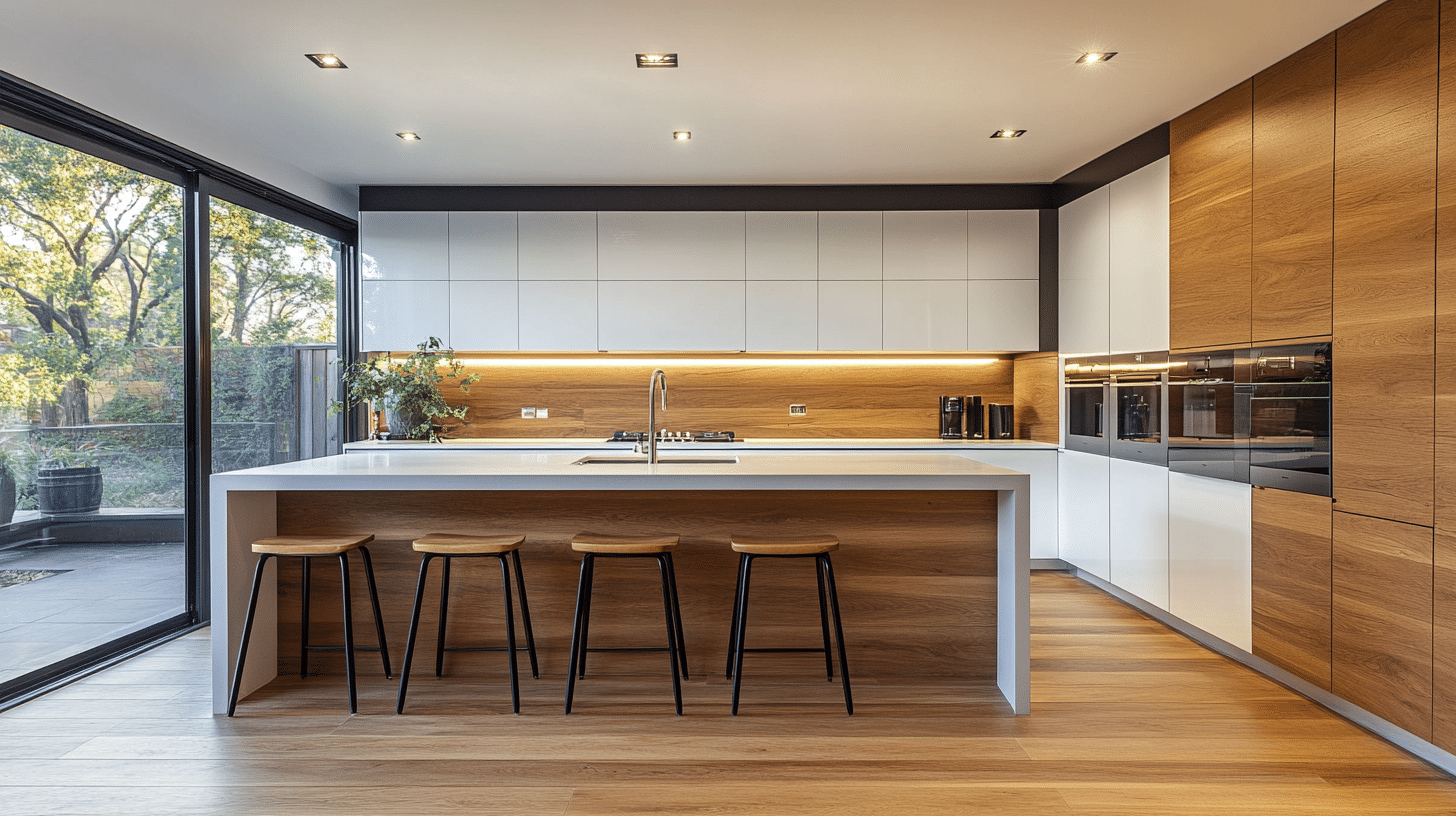Sleek and Chic: Everything You Need to Know About Handleless Cabinets
Handleless cabinets are quickly becoming a must-have in modern kitchens. They offer a sleek, minimalistic look that instantly elevates the space. If you’re seeking a kitchen with clean lines and a contemporary feel, handleless cabinets might be the perfect fit.
However, before you dive in, it’s important to understand how they work, the different types available, and whether they’re right for your home.
In this blog, we’ll cover:
- What handleless cabinets are and how they work.
- The pros and cons of choosing handleless cabinets.
- An overview of different types of handleless cabinets.
- A detailed breakdown of costs, including budget-friendly options.
- Which kitchen designs pair best with handleless cabinets?
- A comparison of handle vs. handleless cabinets to help you choose the right option for your space.
By the end, you’ll know if handleless cabinets are right for you!
What Are Handleless Cabinets, and Why Should You Consider Them?
Handleless kitchen cabinets are a modern take on storage design. These cabinets do away with knobs and pulls, giving your kitchen a smooth, clean look. Instead of handles, they use hidden grips or push-to-open systems.
Many homeowners are turning to handleless kitchen cabinets for their sleek appeal. They create a tidy, uncluttered feel in the kitchen. This style fits well with today’s trend towards simple, open spaces.
Handleless cabinets can make a small kitchen look bigger, and a large kitchen appears more open.
How Do Handleless Cabinets Work?
Handleless kitchen cabinets may seem magic, but their function is simple. Most use one of two methods:
- Recessed grips: These cabinets have a small groove or channel along the top edge. You can slip your fingers into this space to open the door or drawer.
- Push-to-open: These cabinets use a spring-loaded mechanism. A gentle push on the front of the cabinet releases the latch, and the door pops open.
Both types allow easy access without breaking the smooth lines of your kitchen design.
Pros and Cons of Choosing Handleless Cabinets for Your Kitchen
Benefits
- Clean look: Handleless kitchen cabinets create a smooth, unbroken surface across your kitchen.
- Easy to clean: With no handles to work around, wiping down cabinet fronts is quick and simple.
- Safety: There are no protruding handles for people to bump into or catch clothing on.
- Space-saving: You don’t need to account for handle clearance in tight spots.
Potential Downsides
- Cost: Handleless kitchen cabinets can be pricier than traditional options.
- Adjustment period: Getting used to opening cabinets without handles may take time.
- Fingerprints: Some finishes may show fingerprints more easily around the opening areas.
- Repairs: If the opening mechanism fails, it can be harder to fix than simply replacing a handle.
When choosing cabinets, weigh these factors against your needs and preferences. Handleless kitchen cabinets offer a modern touch but are not for everyone. Consider your lifestyle and kitchen habits before making a decision.
Exploring Different Types of Handleless Cabinets
Handleless kitchen cabinets come in various styles, each with its own look and function. Let’s look at some popular types:
1. J-Pull Cabinets: A Seamless Design Choice
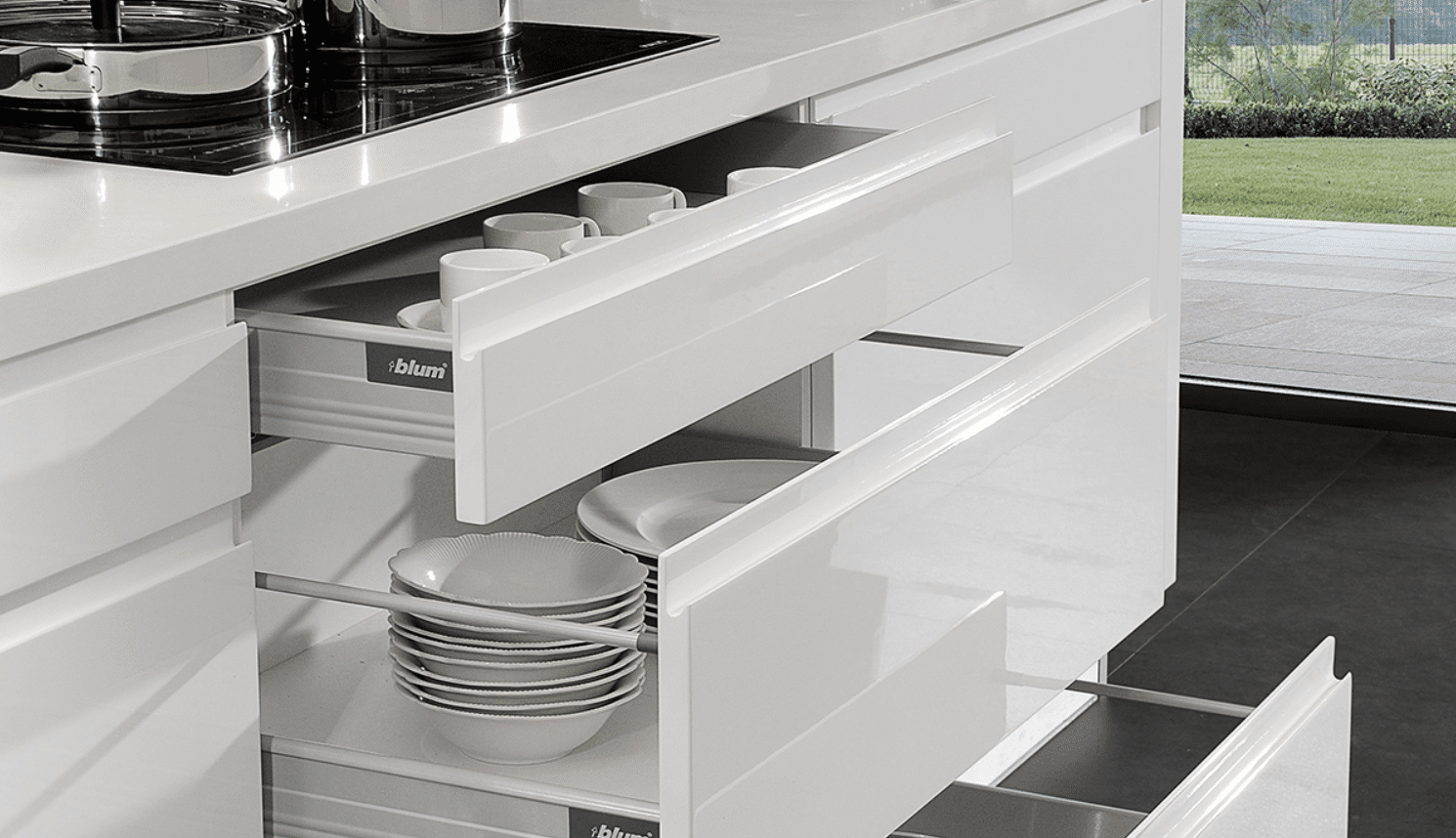
J-pull cabinets get their name from the J-shaped groove at the top of each door or drawer. This groove is a built-in handle, letting you open the cabinet with a simple pull.
These cabinets are a hit in modern kitchens due to their clean lines. They offer a smooth look while still being easy to use. The J-shaped groove blends into the cabinet front, keeping the sleek appearance of handleless kitchen cabinets.
Keep in mind:
- J-pull cabinets can gather dust in the groove
- They may be harder to open for people with large hands
- The design works well with many kitchen styles
2. Push-to-Open Cabinets: A Modern Solution for Effortless Access
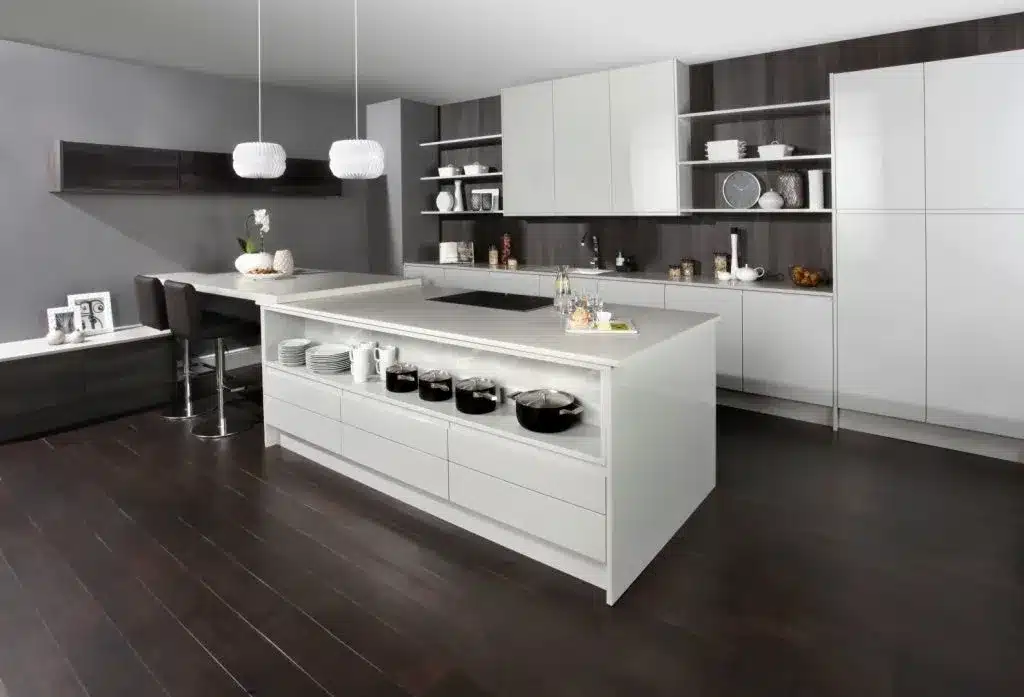
Push-to-open cabinets use a spring-loaded latch. When you press the cabinet front, the latch releases and the door pops open. These handleless kitchen cabinets come in two main types:
- Mechanical: Uses a spring mechanism. It’s simple and doesn’t need power.
- Electrical: Powered by electricity. Often part of “smart” kitchen systems.
Electrical systems can be fancier but may need more upkeep. Mechanical ones are simpler but might need more force to open.
3. Recessed Rails: Sleek and Stylish for a Streamlined Look
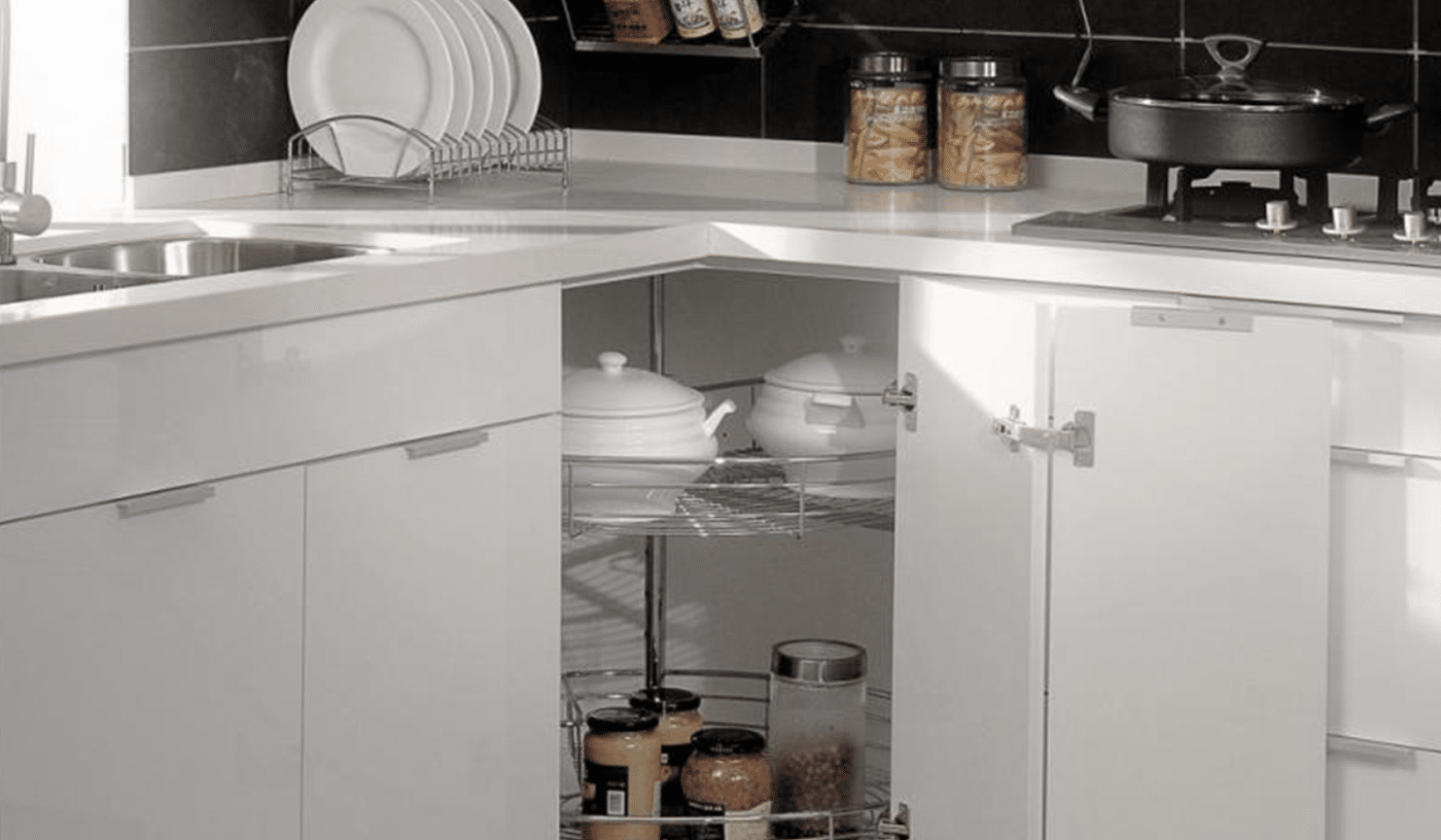
Recessed rail handleless kitchen cabinets have a channel running along the top or side. This channel holds a metal rail that you use to open the cabinet.
These cabinets work well in the following ways:
- Minimalist kitchens
- Industrial-style spaces
- Any kitchen aiming for a clean, modern look
The metal rail can add a subtle accent to your kitchen design.
4. Finger Pulls & Lip Pulls: Combining Style and Function
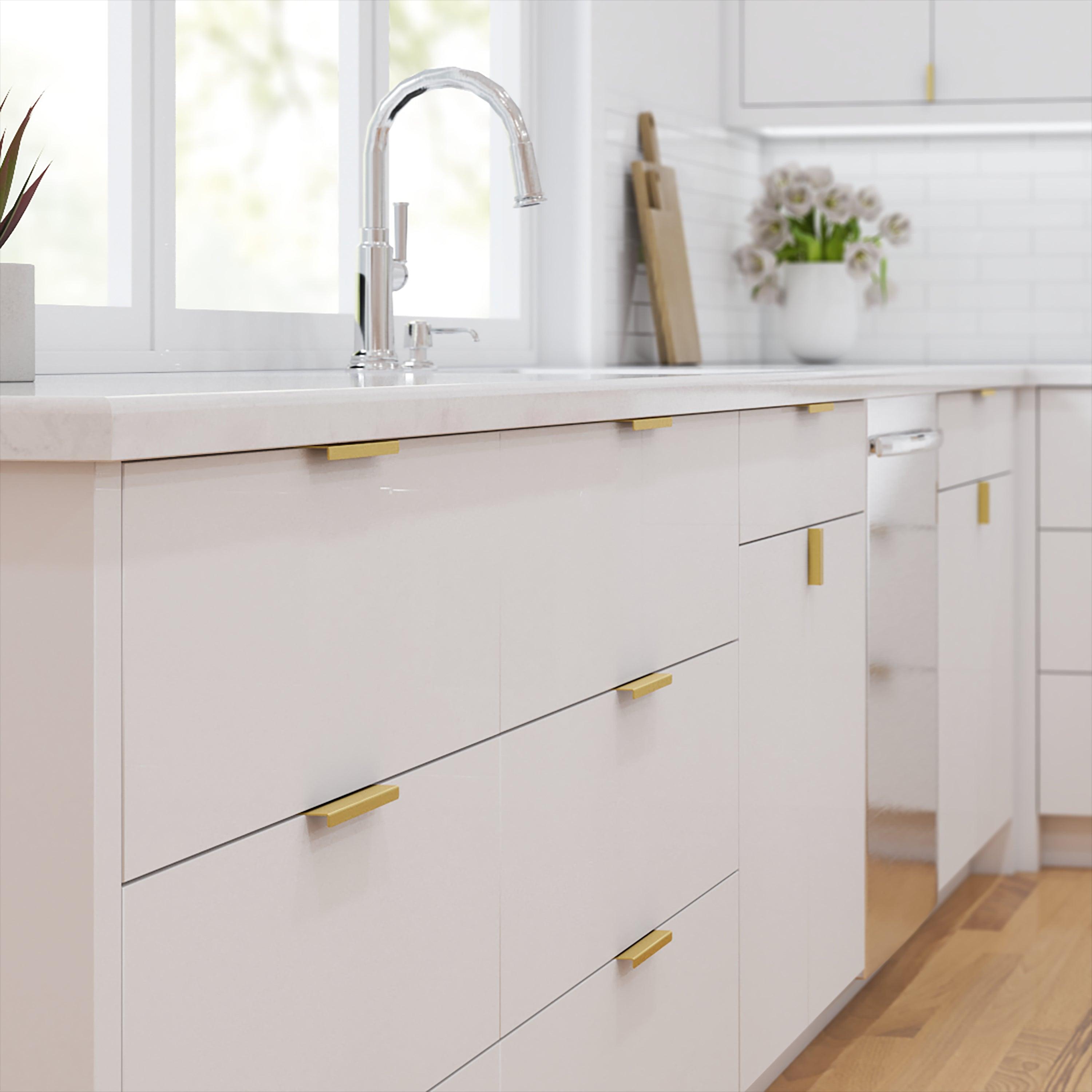
Finger pulls, and lip pulls are small indents or lips on the edge of the cabinet. They give you just enough space to grip and open the door.
These handleless kitchen cabinets offer the following:
- A very minimal look
- Easy opening
- A smooth surface that’s simple to clean
When installing, make sure the pull is easy to grip. The size and placement of the pull can affect how easy the cabinet is to use.
Each type of handleless cabinet has its charm. When choosing, consider your kitchen style and daily habits. The right handleless kitchen cabinets can make your space look great and work well.
Choosing the Right Kitchen Design to Complement Handleless Cabinets
The style of your kitchen can make a big difference in how well handleless cabinets fit in. Let’s look at some kitchen designs that work well with these cabinets.
Minimalist Kitchens: Perfect Harmony with Handleless Cabinets
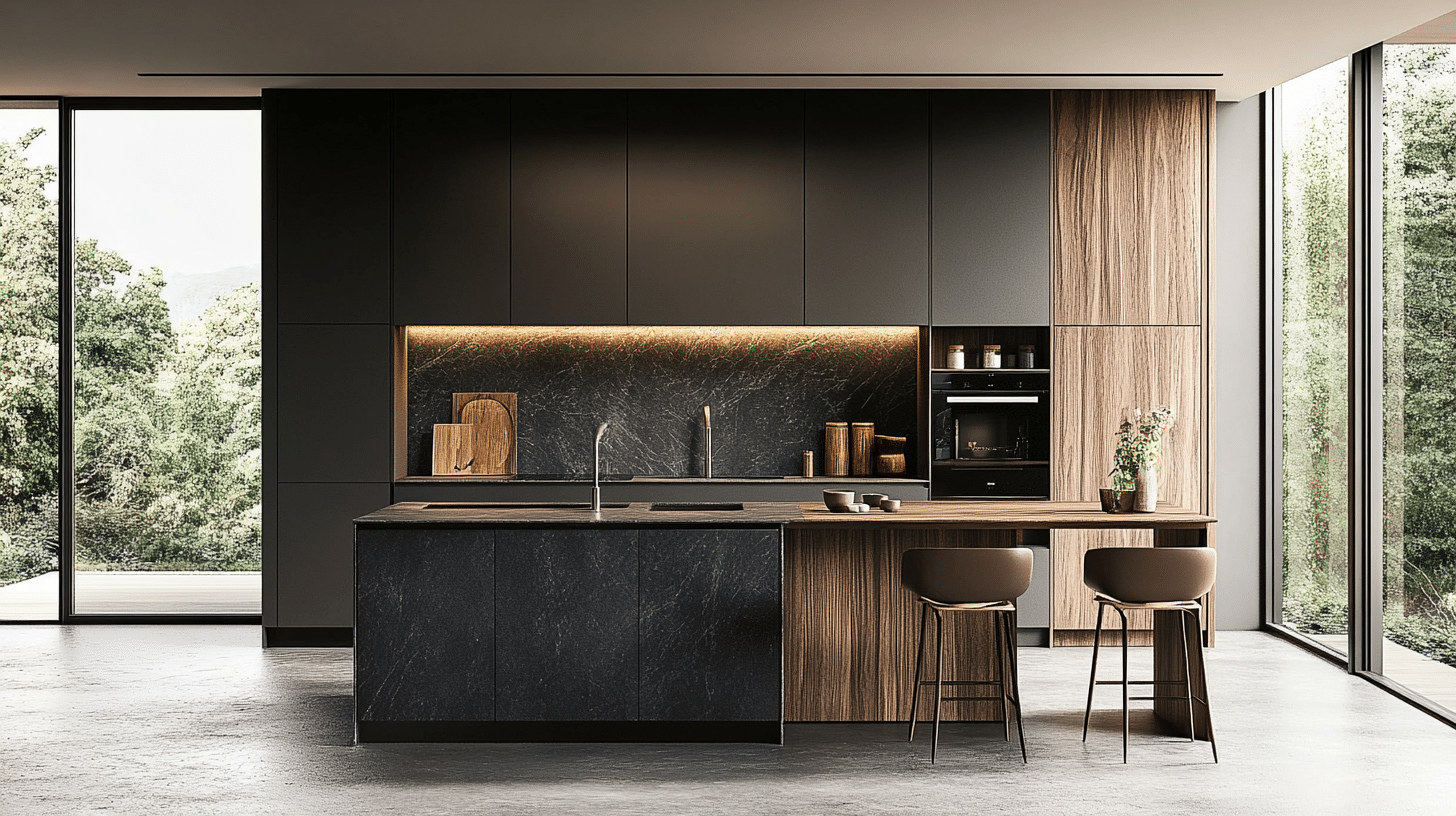
Minimalist kitchens and handleless cabinets are a great match. Both focus on clean lines and simple shapes, and handleless kitchen cabinets help create the clutter-free look that minimalism aims for.
In a minimalist kitchen, handleless cabinets:
- Keep the look smooth and unbroken
- Let other design elements stand out
- Make the space feel larger and more open
The lack of handles perfectly fits the “less is more” idea of minimalism. It creates a calm, tidy feeling in your kitchen.
Scandinavian Kitchens: Warm, Cozy, and Handleless
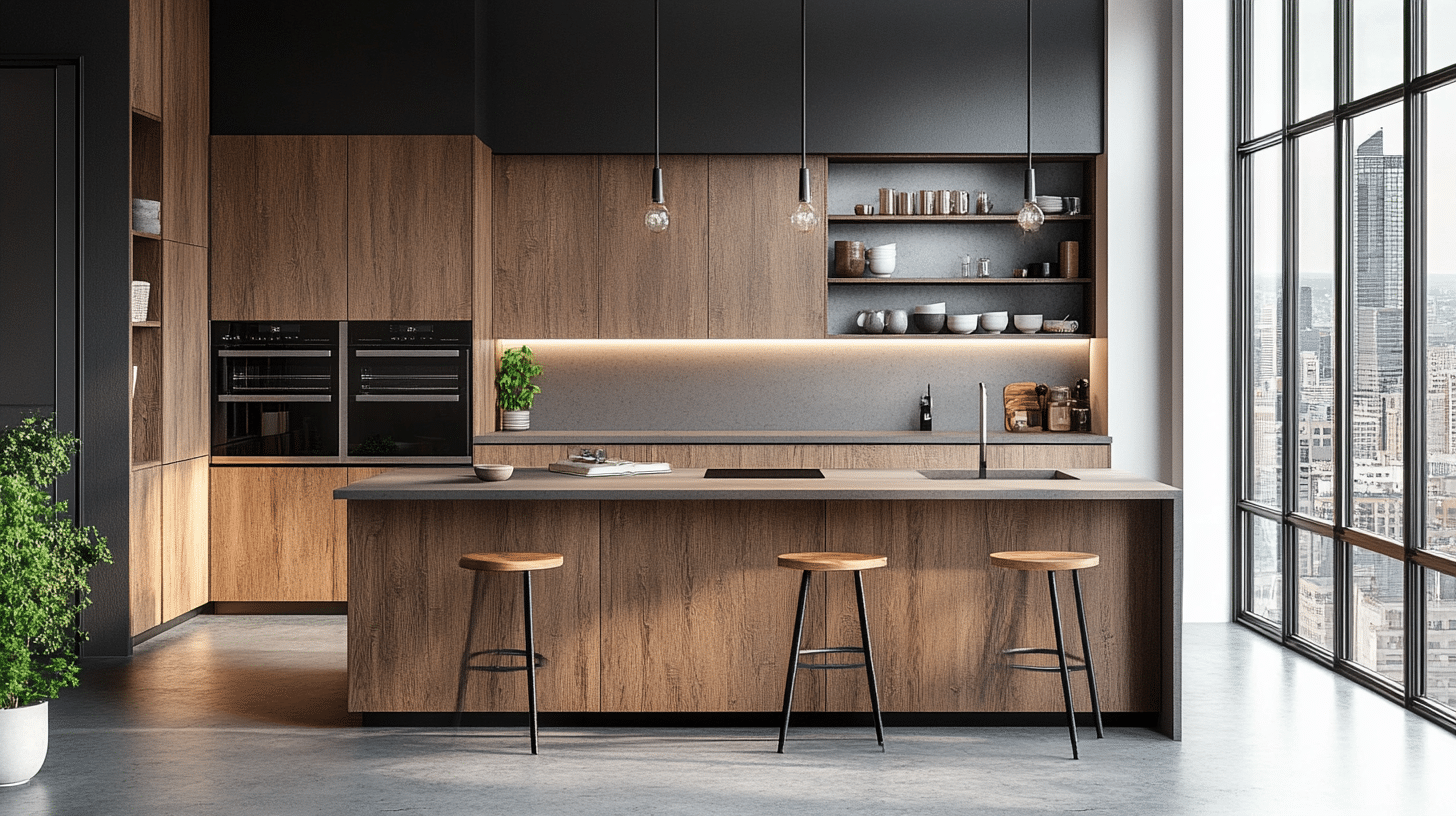
Scandinavian design is known for being simple yet cozy. Handleless kitchen cabinets fit well with this style. They add to the clean look without making the space feel cold.
In a Scandinavian kitchen, handleless cabinets can:
- Keep the space looking neat and organized
- Let warm wood tones or soft colors take center stage
- Blend well with natural materials like wood and stone
The smooth fronts of handleless cabinets match the simple beauty that Scandinavian design is known for. They help create a welcoming space that’s both stylish and practical.
Contemporary Kitchens: Clean Lines for a Sleek Finish
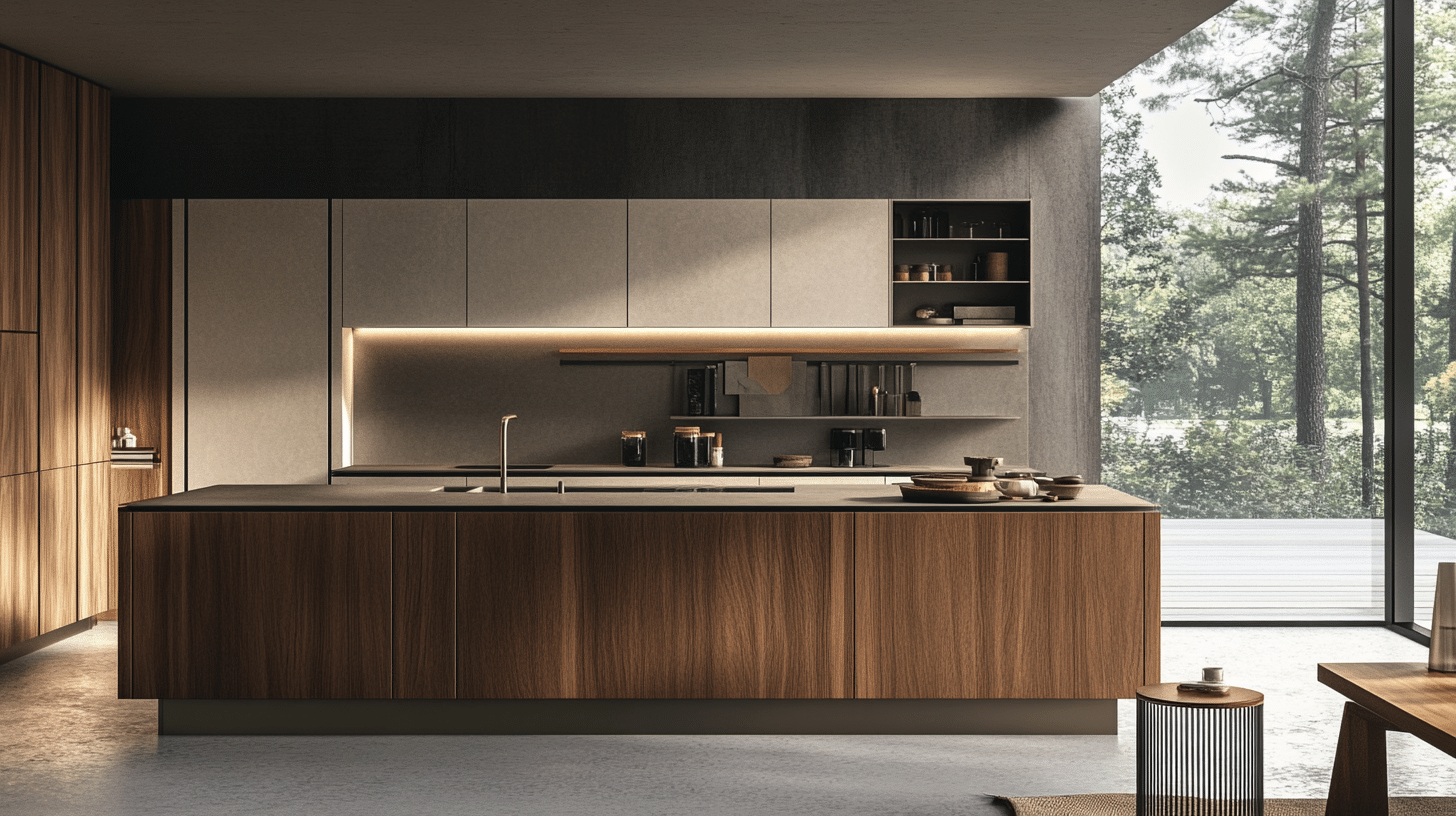
Contemporary kitchens often use sleek designs and new materials. Handleless kitchen cabinets fit right in with this modern approach. They add to the smooth, polished look that contemporary style is all about.
In a contemporary kitchen, handleless cabinets can:
- Create a streamlined, high-tech look
- Work well with glossy finishes and metallic accents
- Help show off unique countertops or backsplashes
The clean lines of handleless cabinets match the forward-thinking feel of contemporary design. They can make your kitchen look cutting-edge without being over the top.
How Much Do Handleless Cabinets Cost?
Handleless kitchen cabinets can add a modern touch to your home but often have a higher price tag. Let’s break down the costs and look at some options:
Factors That Influence the Price Handleless Cabinets Cost
Several things can affect the cost of handleless kitchen cabinets:
- Materials: The type of wood or finish you choose impacts the price. High-end materials cost more.
- Design complexity: Simple designs are usually cheaper. Complex layouts or custom sizes can increase the cost.
- Cabinet type: Push-to-open systems often cost more than J-pull or recessed rail designs.
- Kitchen size: Larger kitchens need more cabinets, which raises the total cost.
- Brand: Well-known brands might charge more for their products.
Cost Breakdown
| Cost Breakdown | Price Range |
|---|---|
| Basic Materials (e.g., MDF) | $3,000 – $6,000 (for a standard kitchen) |
| Premium Materials (e.g., solid wood) | $6,000 – $12,000+ |
| Push-to-Open Mechanism (Mechanical) | $500 – $1,500+ (for the entire kitchen installation) |
| Push-to-Open Mechanism (Electric) | $2,000 – $4,000+ (for the entire kitchen installation) |
| Installation Costs | $1,500 – $3,500+ depending on kitchen size and design complexity |
Handle vs. Handleless Cabinets: Which One Is Right for You?
| Feature | Handle Cabinets | Handleless Cabinets |
|---|---|---|
| Design Aesthetic | Traditional, can fit various styles (classic, rustic, etc.) | Sleek, minimalist, and modern design. |
| Ease of Use | Easy to grip and open with visible handles. | Requires more effort to open (e.g., push-to-open mechanisms). |
| Cost | Generally less expensive due to simpler construction. | It tends to be more expensive due to custom design and mechanisms. |
| Installation | It is easier to install, and less precision is needed for handle placement. | More complex installation, especially with push-to-open or recessed rails. |
| Cleaning & Maintenance | Handles may collect dirt but are easy to clean. | There are no handles to clean, but fingerprints may show on the surface. |
| Durability | Handles may loosen or wear over time. | There are fewer moving parts (in some designs), but push mechanisms can wear out. |
| Customization Options | There is a wide variety of handle styles and materials to choose from. | Limited customization, as the focus is on the cabinet design itself. |
| Suitability for Families | It is easier for children or the elderly to open with visible handles. | Push-to-open cabinets may be harder for small children or the elderly to use. |
| Space Efficiency | Handles may stick out and take up extra space. | The handleless design offers a more streamlined, flush appearance. |
Maintenance Tips for Handleless Cabinets
Handleless kitchen cabinets can keep your kitchen looking sleek and modern. But like any part of your home, they need care to stay in top shape. Here are some tips to keep your handleless cabinets looking great:
1. Regular cleaning
- Wipe down cabinet fronts often with a soft, damp cloth
- Use a mild soap for tougher spots
- Avoid harsh chemicals that might damage the finish
2. Mind the grooves
- For J-pull or grip ledge styles, clean the grooves regularly
- Use a soft brush or old toothbrush to get into tight spaces
- Remove any crumbs or dust that might build-up
3. Handle with care
- Open and close cabinets gently to avoid wear on mechanisms
- Teach children how to use the cabinets properly
4. Deal with fingerprints:
- Use a microfiber cloth to buff out fingerprints on glossy finishes
- For stubborn marks, a mix of warm water and mild dish soap can help
5. Protect the finish:
- Wipe up spills right away to prevent staining
- Use coasters under items that might scratch the surface
6. Check mechanisms:
- For push-to-open systems, test them now and then
- If a mechanism feels off, get it checked before it becomes a bigger issue
7. Mind the edges:
- Pay extra attention to the top edges of drawers and doors
- These areas see the most contact and might need more frequent cleaning
8. Dry thoroughly:
- After cleaning, dry cabinets well to prevent water damage
- This is extra important for wood or wood-effect finishes
9. Yearly deep clean:
- Once a year, give your cabinets a thorough cleaning
- Remove items from inside and clean both in and out
10. Touch up as needed:
- For minor scratches, ask your cabinet maker about touch-up kits
- Address small issues before they become big problems
Following these tips, you can keep your handleless kitchen cabinets looking as good as new. Regular care will help them stay sleek and functional for years to come. Remember, a little effort goes a long way in maintaining the modern look of your handleless cabinets.
Conclusion
Handleless kitchen cabinets offer a modern touch to your cooking space. They blend style with function, creating a clean look that many homeowners enjoy.
While they may cost more and take some time to install, their smooth design can make your kitchen feel larger and easier to clean. Whether you choose J-pull, push-to-open, or recessed rail designs, these cabinets can fit various kitchen styles, from minimalist to contemporary.
Remember to consider your lifestyle, budget, and personal taste when deciding. Regular care will keep your handleless cabinets looking great for years.
As kitchen design trends change, handleless cabinets stand out as a choice combining beauty and practicality. They’re more than just a storage solution—they’re a statement about modern living and streamlined design.

